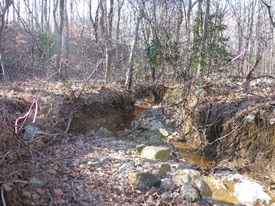Nonstructural Stormwater Controls
Nonstructural Best Management Practices (BMPs) preserve open space, protect nature, and incorporate existing landscape to naturally treat pollutants and prevent them from reaching waterways.
Stream Restoration
Stream restoration reestablishes the general structure, function and self-sustaining behavior of a stream system as it existed before it was disturbed. Restoration design focuses on both the physical and biological components of the stream and its watershed. Restoration uses many measures: removing watershed disturbances that are causing stream instability, installing structures and planting vegetation to protect stream banks and provide habitat, and reconstructing the curves, bends and depth of areas within the stream. Stream restoration projects reduce sediment and nutrients flowing into the Chesapeake Bay.
|
Stream restoration along southbound lane of MD210 in Prince George’s County
|

Before
|
After
|
Disconnecting Impervious Surfaces
Disconnecting impervious surfaces from closed storm drain systems lets natural drainageways carry runoff into underlying soils and natural biological activity to remove pollutants. Stormwater runs off from pavement through vegetated filter strips or side slopes to open ditches and channels. Along the way, pollutants are reduced by vegetative filtering, biological uptake and infiltration. Closed storm drain systems lack this capability.

Open section highway in Howard County with disconnected pavement

Turf filter strip along US 50 in Salisbury